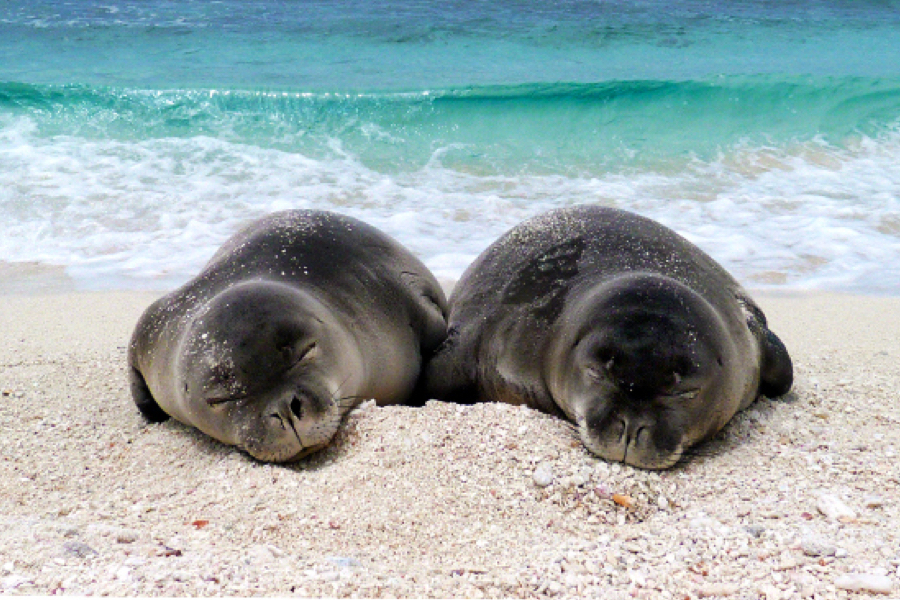Aquaculture
Aquaculture
Marine aquaculture (or farmed seafood) is vital for supporting our nation’s seafood production, year-round jobs, rebuilding protected species and habitats, and enhancing coastal resilience. Aquaculture—the breeding, rearing, and harvesting of animals and plants in all types of water environments—is one of the most resource-efficient ways to produce protein. It has helped improve nutrition and food security in many parts of the world. Globally, aquaculture supplies more than 50 percent of all seafood produced for human consumption—and that percentage will continue to rise.
At NOAA Fisheries, we support cutting-edge science and research as well as federal policy making and regulation to grow sustainable aquaculture in the United States while supporting commercial and recreational fisheries. We also support science, policies, and regulations that allow communities to reap the social, economic, and environmental benefits of aquaculture. We foster responsible aquaculture that provides safe, sustainable seafood; creates employment and business opportunities in coastal communities; and complements NOAA’s comprehensive strategy for maintaining healthy and productive marine populations, ecosystems, and vibrant coastal communities.
Featured News
 Credit: NOAA Fisheries and Partners
Credit: NOAA Fisheries and Partners
Part 2: Seafood Tips from the People Bringing You America's Seafood
 Tal Petty is an oyster farmer in Hollywood, Maryland. Credit: Hollywood Oyster Company
Tal Petty is an oyster farmer in Hollywood, Maryland. Credit: Hollywood Oyster Company

Celebrate Seafood This Holiday Season

Part 1: Seafood Tips from the People Bringing You America's Seafood
Notices & Rules
$1.7 billion worth of aquaculture products
In 2022, estimated freshwater and marine aquaculture production in the United States was 663 million pounds with a value of $1.7 billion.
23 percent of total domestic seafood value
While aquaculture only accounts for 7 percent of total domestic seafood production, its focus on high-value products means that 23 percent of the value of seafood products comes from aquaculture.
The world is turning to oceans for additional food supply
Oceans cover 71% of the Earth’s surface, but currently account for only 2% of our food supply. With limited arable land and freshwater, the world is turning to the oceans for additional food supply as the global population is projected to reach 9 billion by the year 2050.
U.S. Aquaculture
We are working hard to foster the growth of aquaculture in the United States not only to help meet U.S. seafood demand, but also to help encourage job growth. We are involved in a variety of aquaculture activities around the country and offer assistance through our regional aquaculture coordinators.
Global Aquaculture
Fisheries and aquaculture remain important sources of food, nutrition, income and livelihoods for hundreds of millions of people around the world. World per capita fish supply reached a new record high of 20 kg in 2014. This is thanks to vigorous growth in aquaculture and to a slight improvement in the state of certain fish stocks due to improved fisheries management. Aquaculture now provides half of all fish for human consumption.
Shellfish Aquaculture
Shellfish farming and restoration is critical to get more oysters, clams, and mussels in the water for food, jobs, and ecosystem services. We are working with partners to address environmental research, spatial planning, permitting, restoration, and farming techniques for shellfish aquaculture.
Learn more about the National Shellfish Initiative
Learn more about best management practices, standards, and certification programs
Finfish Aquaculture
In the United States, aquaculture technologies and management practices have continued to evolve through lessons learned and significant public and private research focused on bringing greater efficiency, sustainability, and cost-effectiveness to aquaculture. A variety of techniques and technologies—each with its own advantages and disadvantages—can be used to raise finfish.
Funding Opportunities
There are a number of financial assistance programs that support sustainable aquaculture in the United States. Funding can address a variety of issues such as environmental monitoring, recirculating aquaculture systems, shellfish farming, alternative feeds, new species research, and offshore aquaculture.
Aquaculture Outreach
Many stakeholders want to understand the challenges and benefits of aquaculture, especially as communities look for ways to maintain working waterfronts and diversify their seafood portfolio. Providing outreach materials with accurate information about aquaculture research, management practices, and key initiatives is vital to cultivating public understanding of farmed seafood.
Understanding Marine Aquaculture
The United States has a small and vibrant commercial marine aquaculture industry supported by world class research and technology.
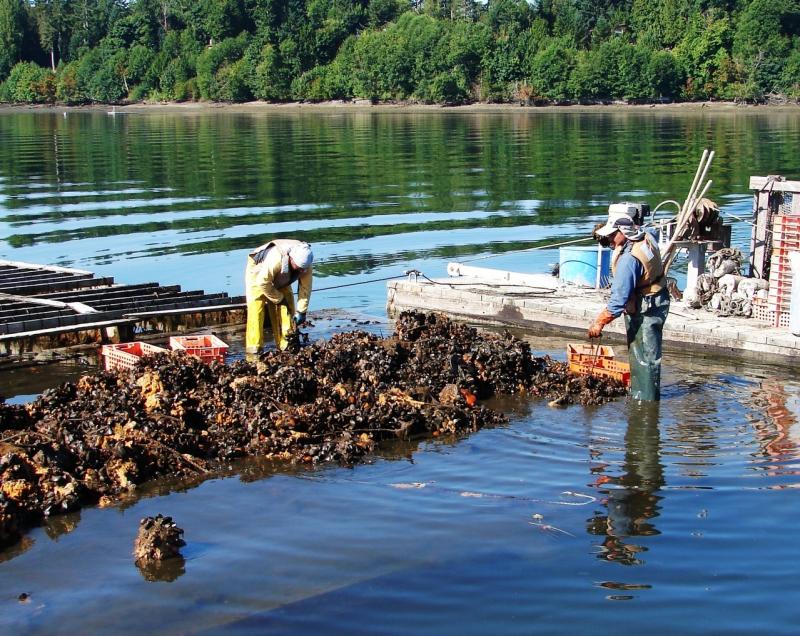
Multimedia
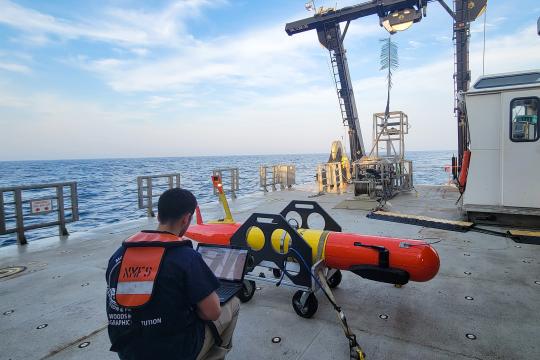 Woods Hole Oceanographic Institution engineer Owen Ceserano downloads images collected from a long-range autonomous underwater vehicle called “Stella” on deck of R/V Hugh R. Sharp. HabCam can be seen in the background. Credit: NOAA Fisheries/Zach Fyke
Woods Hole Oceanographic Institution engineer Owen Ceserano downloads images collected from a long-range autonomous underwater vehicle called “Stella” on deck of R/V Hugh R. Sharp. HabCam can be seen in the background. Credit: NOAA Fisheries/Zach Fyke
2024 Winter News Roundup
 Mike Acquafredda holding a tray of sea beans. Credit: NOAA Fisheries/Mike Acquafredda
Mike Acquafredda holding a tray of sea beans. Credit: NOAA Fisheries/Mike Acquafredda
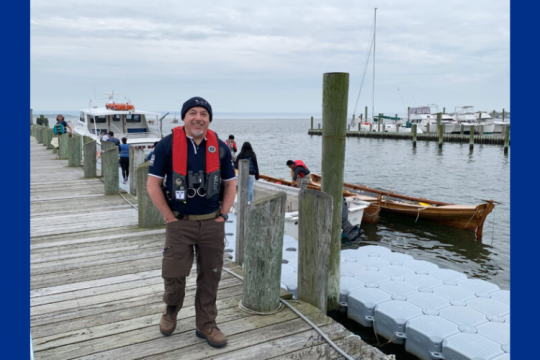 Teacher at Sea Roy Arezzo on a dock for a rowing race. Courtesy: Roy Arezzo
Teacher at Sea Roy Arezzo on a dock for a rowing race. Courtesy: Roy Arezzo
Regulation and Policy

United States marine aquaculture operates within one of the most comprehensive regulatory environments in the world. Aquaculture operations must meet a number of federal, state, and local regulations that ensure environmental protection, water quality, and healthy oceans. Science and transparent public engagement inform NOAA policy, regulatory, and management decisions regarding sustainable aquaculture development.
The National Aquaculture Act of 1980 established aquaculture as a national policy priority for the United States. It also created an interagency Subcommittee on Aquaculture, through which NOAA coordinates with other federal agencies on regulatory, policy, economic, and science aquaculture-related activities.
NOAA Fisheries plays a central role in developing and implementing aquaculture policies for both NOAA and the Department of Commerce. NOAA ensures that aquaculture activities comply with federal laws, regulating marine aquaculture under a suite of federal statutes designed to sustain healthy oceans.
NOAA Aquaculture Policies
Both established in 2011, these policies provide federal guidance for all aquaculture-related activities at NOAA and the Department of Commerce.
- NOAA Marine Aquaculture Policy specifies goals, objectives, and priorities for all aquaculture-related activities at NOAA in the context of its marine stewardship mission
- Department of Commerce Aquaculture Policy specifies goals, objectives, and priorities for all Department of Commerce bureaus, including NOAA, in the context of the Department's overarching emphasis on jobs, the economy, innovation, and international competitiveness
Executive Order on Promoting American Seafood Competitiveness and Economic Growth
A May 2020 Executive Order, Promoting American Seafood Competitiveness and Economic Growth, calls for the expansion of sustainable U.S. seafood production.
Section 6
Section 6 states that NOAA will serve as the lead agency for National Environmental Policy Act review for aquaculture projects when the projects meet all three of the following criteria:
- Located within the Exclusive Economic Zone and outside of the waters of any state or territory
- Require environmental review or authorization by two or more federal agencies
- The agency that would otherwise be the lead agency has determined that it will prepare an environmental impact statement
As lead agency, NOAA is responsible for completing the environmental impact statement process in cooperation with the main permitting agencies.
Section 7
NOAA is identifying Aquaculture Opportunity Areas, defined geographic areas that have been evaluated to determine their potential suitability for commercial aquaculture. NOAA is using the best available science and public input to look for spaces that are environmentally, socially, and economically appropriate for aquaculture development.
Section 8
NOAA Fisheries’ Guide to Permitting Marine Aquaculture in the United States assists individuals with navigating the federal permitting process for marine aquaculture (finfish, shellfish, invertebrates, seaweed). The Guide to Federal Aquaculture Grant and Financial Assistance Services lists programs for which aquaculture farmers or aquaculture researchers may be eligible.
Section 9
The Subcommittee on Aquaculture is preparing a National Aquaculture Development Plan. It supports the expansion of existing operations, encourages new entrants, and maximizes the effectiveness of existing federal policies and programs, while strengthening public-private partnerships.
Interagency Subcommittee on Aquaculture
NOAA is a co-chair of the Subcommittee on Aquaculture. The subcommittee coordinates federal agencies to increase the overall effectiveness and productivity of federal aquaculture research, regulation, technology transfer, and assistance programs.
National Shellfish Initiative
The National Shellfish Initiative aims to increase populations of bivalve shellfish (oysters, clams, and mussels) in our nation's coastal waters through commercial production and conservation activities. Efforts focus on encouraging shellfish aquaculture, advancing science and research, and promoting regulatory efficiencies at federal, state, and local levels.
The Washington Shellfish Initiative was the first partnership to focus on restoring and expanding resources to promote shellfish aquaculture and create family-wage jobs within Washington state. Today, there are a growing number of states with shellfish initiatives.
State-by-State Summaries of Leasing/Permitting Requirements
Science and Technology
We are working to address the technical and scientific barriers of marine aquaculture and to provide science information for management in a number of ways. We do this through in-house research at NOAA, grants and cooperative agreements with Sea Grant and other stakeholders, and by coordinating research with other federal agencies.
Aquaculture Research at NOAA Fisheries
Several NOAA Fisheries Science Centers explore a wide spectrum of aquaculture issues. These include the culture of specific species, life-cycle analysis, alternative feeds, ocean acidification, and habitat benefits and impacts.
For example, the Northeast Fisheries Science Center Milford Laboratory, established in 1931, is located on the shore of Long Island Sound. The facility comprises two laboratory/office buildings and support buildings housing raceway and circular tanks. A 49-foot vessel, the R/V Victor Loosanoff, is also docked at the Laboratory for nearshore research. Present research emphasizes aquaculture and habitat-related work. The aquaculture program includes studies of the culture of fish and shellfish to develop methods suitable for commercial use as well as for stock enhancement and restoration. Nearshore habitats are being studied to determine what characteristics make a habitat suitable for a particular species.
Additionally, the Northwest Fisheries Science Center Environmental and Fisheries Science Division conducts research to improve methods for fisheries restoration and production in conservation hatcheries and in aquaculture. Research focuses on the effects of ocean acidification on shellfish, shellfish safety (harmful algal blooms and pathogens), and native Olympia oyster restoration. Lab research also includes alternative marine fish feeds, larval fish physiology and nutrition.
At the NOAA Beaufort Laboratory, scientists from NOAA Fisheries and National Ocean Service conduct a variety of research including harmful algal blooms, seafloor mapping, and aquaculture.
Explore Aquaculture Research
NOAA has marine aquaculture research capabilities at in-house laboratories within NOAA Fisheries and the National Ocean Service. We also have research and extension capabilities through state Sea Grant programs. This story map covers the in-house projects funded by the NOAA Fisheries Office of Aquaculture. The research explores a wide spectrum of relevant aquaculture issues. These include the culture of specific species, life-cycle analysis, alternative feeds, ocean acidification, and potential habitat benefits and impacts. This Story Map serves as a tool to highlight NOAA's aquaculture research and as well as to connect researchers with topics of common interest. It is updated periodically as new projects are planned and implemented.
Story Map: NOAA Aquaculture Research
Funding Research and Technology
Since 1998, NOAA has funded aquaculture projects through the Sea Grant Marine Aquaculture grant program, a competitive grants program coordinated by the National Sea Grant College Program. Several other grant opportunities are administered or funded through NOAA Fisheries. Together these grants have funded projects that have responded to key scientific, engineering, environmental, and economic questions. These include studies of candidate species, health and nutrition, best management practices, ecosystems monitoring and management, engineered production systems, and legal and operational frameworks.
Aquaculture Funding Opportunities Directory
Regional Activities
Aquaculture is present along our coasts and in our oceans across the nation. Activities and products vary by region so we have regional coordinators supporting these activities and increasing awareness of region-specific issues.
Alaska
The Alaska mariculture industry produces shellfish and aquatic plants along Alaska’s coastline. As of 2016, mariculture activity in Alaska consists of approximately 75 operations, including 65 authorized farms, seven nurseries, and three hatcheries. Most operations are located along the coastline in either Southeast or Southcentral Alaska.
New England/Mid-Atlantic
The New England/Mid-Atlantic region has a commercial marine aquaculture industry supported by a research and technology sector. Landings from marine aquaculture (predominantly Atlantic Salmon and oysters, but also clams, mussels, and other species) totaled approximately $219 million in this region in 2013. This makes aquaculture the third most valuable fishery in the region in terms of economic revenue, behind scallops and American lobster.
Farmed items in New England and the Mid-Atlantic include finfish, shellfish, and sea vegetables grown as food for human consumption. Hatchery-raised species are also used habitat (e.g., oyster) and endangered species (e.g., Atlantic salmon) restoration.
Aquaculture in New England and the Mid-Atlantic
Northwest
In the Pacific Northwest, we work closely with regional tribes, the states of Washington, Oregon, and California, the aquaculture industry, and non-governmental organizations. This work focuses on fish, shellfish, and algae species. Washington State is our nation's leading producer of farmed shellfish. The region primarily grows oysters, mussels, clam, as well as Atlantic and Pacific salmon species.
We also work with partners to responsibly restore populations of native Olympia oysters, pinto abalone, and Pacific salmon. Aquaculture-related research at the Northwest Fisheries Science Center focuses on the effects of ocean acidification on shellfish, shellfish safety (harmful algal blooms and pathogens), and native Olympia oyster restoration.
Pacific Islands
The Pacific Islands region primarily grows finfish, such as kampachi (Seriola rivoliana), shrimp, and marine algae for commercial purposes.
Aquaculture in the Pacific Islands
Southeast
In the southeast, marine aquaculture focuses on stock enhancement, food production, research, and restoration efforts. Species cultured in the region include oysters, clams, red drum, spotted sea trout, flounder, snook, pompano, black sea bass, and algae. Aquaculture occurs on land in recirculating systems or ponds as well as in coastal areas or state waters. We have also provided funding for projects related to culture of red snapper, blackfin tuna, cobia, and baitfish species as well as for research into alternative diets for marine finfish.
Southwest
California primarily grows Pacific oysters, Kumamoto oysters, and manila clams for commercial purposes. They also farm Mediterranean mussels, Atlantic oysters, red abalone, rock scallops, and seaweed. Research in the Southwest focuses on abalone recovery at the Southwest Fisheries Science Center and Olympia oyster restoration by various sectors of academia, primarily in the San Francisco Bay area.
More Information
Outreach
Sustainably farmed seafood is a smart choice for healthy people, a healthy economy, and a healthy planet. Most of the public still has limited understanding of aquaculture and may encounter information that can be out of date, inaccurate, or incomplete. Science communications sources that share accurate information can increase aquaculture and sustainable seafood literacy.
Fact Sheets
Regional Fact Sheets
Each region of the United States features different ecosystems, a variety of water temperatures, and many different species. Just like their wild counterparts, aquaculture species need the right conditions to grow. Explore the regional aquaculture fact sheets to learn about the species, grow-out methods used, and the economic importance of aquaculture by region.
Deep-Dive Fact Sheets
Seafood farming, if done responsibly—as it is in the US—is increasingly recognized as one of the most environmentally sustainable ways to produce food and protein. Farmed seafood requires far less feed than most terrestrial animals, and thirty years of lessons learned have been put into practice in U.S. aquaculture farm management and regulatory requirements. Learn more about the many facets of science-based, sustainable aquaculture in the U.S.:
- Antibiotic Use in Finfish
- Aquaculture and Environmental Interactions
- Aquaculture Provides Beneficial Ecosystem Services
- Climate Resilience and Aquaculture
- Disaster Assistance for Fisheries
- Marine Aquaculture in the U.S.
- Potential Risks of Aquaculture Escapes
- Regulation of Marine Aquaculture
- Sustainable Aquaculture Feeds and Fish Nutrition
Frequently Asked Questions
- Aquaculture Opportunity Areas
- Feeds for Aquaculture
- Marine Aquaculture and the Environment
- Understanding Marine Aquaculture
- Understanding Shellfish Aquaculture
Aquaculture Videos
Marine aquaculture refers to the breeding, rearing, and harvesting of aquatic plants and animals. Faced with limited fresh water and land resources, seafood farmers are cultivating the ocean. These videos explore the challenges and benefits of marine aquaculture:
- Alaska Kelp Farming: A New Sustainable Seafood Opportunity
- Aquaculture Opportunity Areas
- The Future of Ocean Farming
- Innovative Aquaculture Tools for a Growing Industry
- Milford Lab's GoPro Aquaculture Project
- No Shell Left Behind (2020 Emmy winner)
- Ocean to Table: Stories of Food, Farming, and Conservation
Eat More Seafood
Choosing to eat more seafood is good for your health and the environment. Use these guides to master easy and flavorful seafood recipes:
- FishWatch Recipes
- Oregon Sea Grant Recipes
- Seafood Nutrition Partnership Recipes
- 9 Seafood Recipes That Will Take Your Taste Buds on Vacation
Try something new: learn how to cook Kelp Noodles Fra Diavolo.
Not sure where to start? Check out Seafood: A Fare for Every Palate for help choosing a recipe.
Aquaculture Opportunity Areas
An Aquaculture Opportunity Area (AOA) is a defined geographic area that has been evaluated to determine its potential suitability for commercial aquaculture.
NOAA is using a combination of scientific analysis and public engagement to identify areas that are environmentally, socially, and economically appropriate for commercial aquaculture.
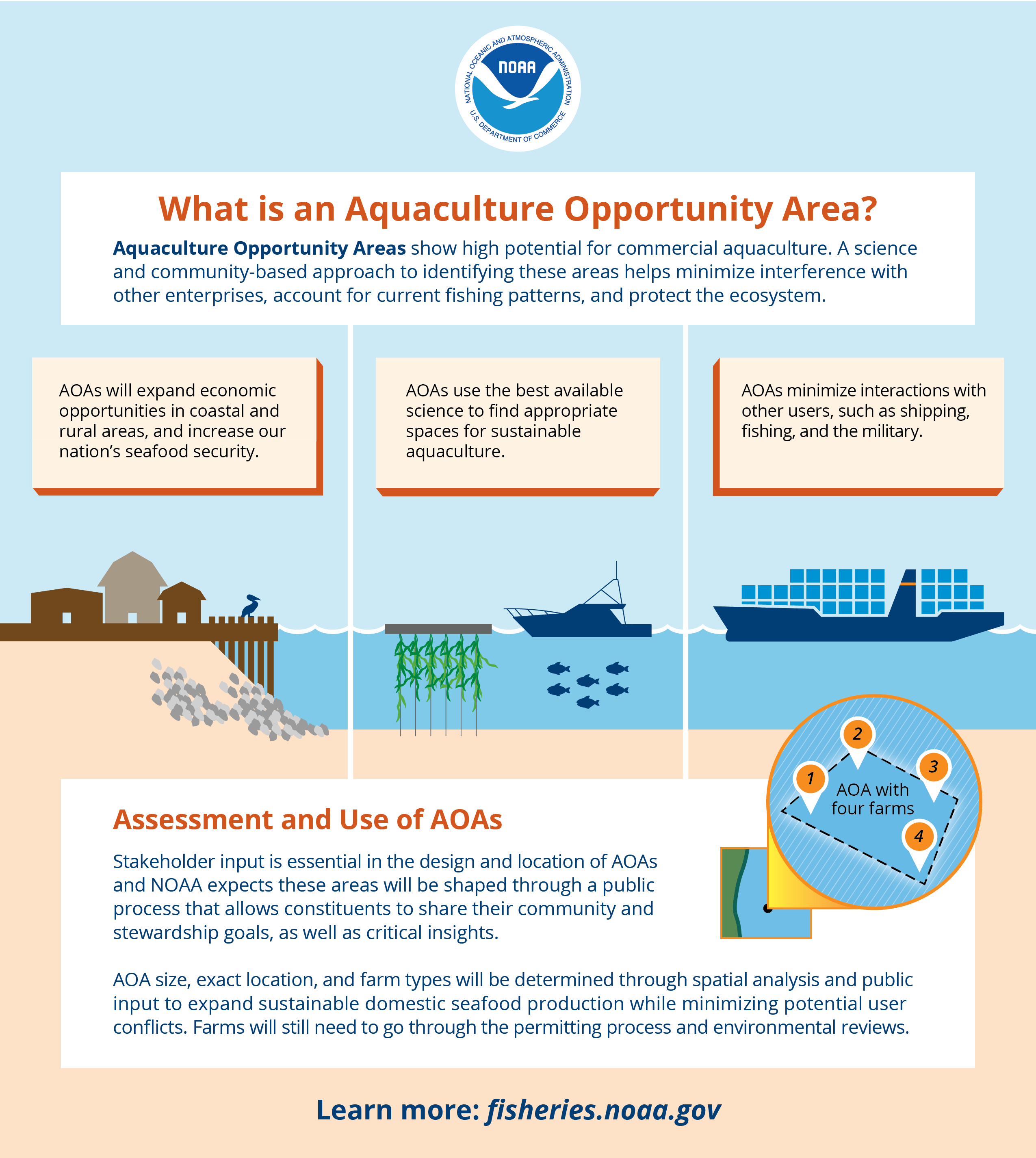
How NOAA Will Identify Aquaculture Opportunity Areas
NOAA uses a combination of spatial mapping, scientific review, and stakeholder input to identify AOAs.
The AOA identification process begins by selecting a region of interest, then narrowing that region into smaller study areas. These smaller study areas are needed for NOAA’s National Centers for Coastal Ocean Science to conduct effective aquaculture spatial modeling. NCCOS uses the best available data to account for key environmental, economic, social, and cultural considerations (i.e. fishing and protected areas) in this spatial modeling to identify areas that may support sustainable aquaculture development.
The spatial modeling results are one source of information NOAA uses in identifying AOAs. NOAA combines the spatial modeling results with input from Fishery Management Councils, Marine Fisheries Commissions, states and tribes, the general public, and other sources to develop preliminary alternatives to be considered through a programmatic review under the National Environmental Policy Act (NEPA). The NEPA review will consider alternative scenarios for siting aquaculture within the study areas and will present the best available science on the potential effects of siting aquaculture within the areas.
Identification of AOAs happens at the end of this process, after the NEPA review is complete. This results in identification of a defined geographic area that has been evaluated through a combination of scientific analysis and public engagement to determine its potential suitability for commercial aquaculture.
Why is NOAA Identifying Aquaculture Opportunity Areas?
NOAA has directives to preserve ocean sustainability and facilitate domestic aquaculture in the United States through the National Aquaculture Act of 1980, the NOAA Marine Aquaculture Policy, and Executive Order 13921, “Promoting American Seafood Competitiveness and Economic Growth” (May 7, 2020). NOAA has a variety of proven science-based tools and strategies that can support these directives. These help stakeholders thoughtfully consider how and where to sustainably develop offshore aquaculture that will complement wild-capture fisheries, working waterfronts, and our nation’s seafood processing and distribution infrastructure.
Identifying AOAs is an opportunity to use the best available global science-based guidance on sustainable aquaculture and support the “triple bottom line” of environmental, economic, and social sustainability. This approach has been refined and utilized widely within states and by other countries with robust, sustainable aquaculture sectors.
Considering NOAA-trust resources and stakeholder uses of a defined area will help to encourage the sustainable growth of aquaculture. This is done by siting aquaculture farms in ways that minimize impacts to those natural resources and reduce user conflicts while maximizing public input in the AOA identification process.
Aquaculture Opportunity Area Publications to Date
- Gulf of Mexico* AOA Atlas
- Public Scoping Summary for Gulf of Mexico
- Southern California AOA Atlas
- Public Scoping Summary for Southern California
More Resources
Webinars
Web Stories
- NOAA Fisheries Selects Alaska to Begin Aquaculture Opportunity Area Identification (6/1/23)
- Considering Culture for Aquaculture: NOAA’s Efforts to Expand Aquaculture Social Science Capacity (8/15/22)
- Aquaculture Opportunity Areas Featured at Aquaculture America 2022 (4/11/22)
- Public Provides Important Insights Into Aquaculture Opportunity Areas (2/12/21)
- NOAA Announces Regions for First Two Aquaculture Opportunity Areas Under Executive Order on Seafood (8/20/20)
*Executive Order 14172, “Restoring Names That Honor American Greatness” (Jan. 20, 2025), directs that the Gulf of Mexico be renamed the Gulf of America. On August 7, 2025, NOAA Fisheries and the National Ocean Service amended regulations in the Code of Federal Regulations to reflect the renaming. The name change did not result in any changes to, and had no effect on the applicability or enforceability of, any existing regulations. This website continues to use “Gulf of Mexico” when quoting statutes or previously published materials.
More Information
- Alaska Aquaculture Opportunity Area Website
- Alaska AOA Request for Information - Now open for public comment until December…
- Southern California Aquaculture Opportunity Area
- Gulf of America Aquaculture Opportunity Area Environmental Impact Statement
- Frequently Asked Questions: Aquaculture Opportunity Areas
